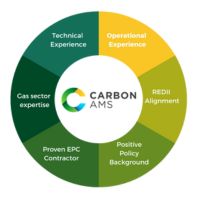We convert ‘grass to gas’
We are a single-source developer and manager of anaerobic digestion (AD) plants across Ireland and the UK. We convert “grass to gas” using the Carbon AMS pioneering approach to managing nutrients in the land. This unique energy biosystem ensures the highest grade biomethane, nutrient-rich bio-fertiliser and improved biodiversity. Farming families benefit from a sustainable source of income, and the potential to realise value from carbon buildup on their farms.
What We Do
Renewable
Energy
End-to-end AD and green gas service platform. We build it, we drive it and we fuel it. Designing, building and commissioning AD plants to create green gas using purpose grown grass.
Innovative
Approach
We deploy farm-level carbon and feedstock innovations to allow farm and commercial scale AD plants to meet EU REDII requirements and reduce feedstock and digestate costs.
Carbon Capture & Biodiversity
Through our methods of regenerative farming carbon is captured and removed from the atmosphere, mitigating the effects of global warming. We aim to enhance biodiversity around our facilities through space-for-nature areas, habitat management and conservation, wildlife corridors and by planting native trees.
About Carbon AMS
Carbon AMS, established in 2022, is an Anaerobic Digestion (“AD”) development platform focused on biomethane production in Northern Ireland and the Republic of Ireland.
‘Grass to gas’
We convert “grass to gas” through AD to produce biogas, which can be upgraded to biomethane, using the pioneering Carbon AMS approach. The biomethane is produced to meet the standards required to ensure RED II certification, a sustainability certification set by the European Commission.
Leadership team
Our leadership team offers a unique skillset. Bringing together significant experience in the development of an exclusive agri-tech solution well suited to biomethane production as well as experience of developing and operating farm and commercial scale AD plants in Ireland and the UK for a variety of institutional investors.
Working with feedstock suppliers
We work with feedstock suppliers to measure and manage nutrients in the land to grow healthy grass. This ensures the highest grade biomethane and nutrient-rich bio-fertiliser as well as improved biodiversity. Farming families benefit from a sustainable source of income, and the potential to realise value from carbon buildup on their farms.
Significant experience
We bring together a wealth of experience in project design, construction, and management to allow each facility to reach its maximum potential. This experience, combined with our extensive agricultural knowledge allows us to manage the land we manage in a sustainable way to create the perfect renewable gas solution.
Carbon AMS
Meet the team
The Carbon AMS team comprises seasoned professionals with extensive expertise in the renewable gas and agri-food sectors. Led by CEO Richard Kennedy, an EY Entrepreneur of the Year Award winner, the team has a proven track record of managing biogas and biomethane projects across Ireland and Europe.

RICHARD KENNEDY
CEO
Richards previous roles include CEO of Devinish Nutrition and he is a previous winner of the EY Entrepreneur of the Year Award.

PAUL KINSGTON
COO
Paul has a wealth of experience specializing in engineering and financial services to biogas & biomethane projects.

PATRICK HARTE
CTO
Patrick developed an engineering business which specializes in Anaerobic Digestion facilities.

RIAN KENNEDY
Biodiversity & Carbon Lead
With 15 years experience, Rian has a Masters in Agriculture Science focusing on sustainable farming practices.

MATTHEW LANG
Feedstock & Biomethane Lead
Matthew has 5 years experience in the industry with extensive knowledge in nutrient recovery systems.

GET IN TOUCH
We’re here to help
Out team of experts are here to answer all your queries. Why not get in touch with us today to discuss your project.
Frequently Asked Questions
What is Anaerobic Digestion?
AD is the conversion of organic materials by micro-organisms in the absence of oxygen into biogas and digestate. It is a natural process that takes place in a series of sealed and airtight tanks ensuring there are no odours associated with the plant. The biogas is then cleaned and upgraded to biomethane which can be used as a renewable replacement for fossil fuels, such as natural gas, in homes, industry and transport. This entire process is natural, with all inputs and outputs recycled, leaving no waste. The first anaerobic digestion plant was built in 1859 and the technology has advanced steadily since then. Today the technology enables countries such as Denmark to replace 34% of their natural gas consumption with biomethane, with an ambition to replace 100% by 2030.
What is Biogas?
Biogas is a mixture of methane, CO2 and small quantities of other gases produced by anaerobic digestion of organic matter in an oxygen-free environment. The precise composition of biogas depends on the type of feedstock and the production pathway. The methane content of biogas typically ranges from 49% to 56% by volume, with most of the remainder being CO2.
What is Biomethane?
Biomethane (also known as “renewable natural gas”) is a near-pure source of methane produced by “upgrading” biogas in a process that removes any CO2 and other contaminants present in the biogas. Biomethane is indistinguishable from natural gas and can be used without the need for any changes in transmission and distribution infrastructure or end-user equipment and is fully compatible for use in natural gas vehicles.
What is Biomethane used for?
Biomethane will play a key role in reducing emissions across some of the most important sectors of the economy including heating, industry, transport, and power generation, while also supporting the decarbonisation of the agri-food sector. This renewable energy is structurally identical to natural gas and can be used in the same way through the existing infrastructure such as boilers and other appliances. This means homeowners and businesses will be able to transition to this sustainable energy source and play their part in progressing Ireland towards a cleaner energy future, without changing a thing. To be introduced into the gas network, this biogas must meet the quality standards as required by Gas Networks Ireland.
What happens to the CO2?
Most people primarily know carbon dioxide as a greenhouse gas that contributes to climate change. It is true that CO2 harms our environment when it is released into the air, but carbon dioxide also has many different applications across a wide range of industries. At Carbon AMS, we capture this CO2 from the air and use it. Carbon dioxide is used in the Food and Beverage industries for carbonating drinks like beer, soft drinks and wine. Carbon dioxide can carry energy as a refrigerant. Solid CO2, better known as dry ice, keeps food products cold while they are being transported.
What feedstocks do the Carbon AMS facilities use?
All Carbon AMS facilities only utilise locally produced agricultural derived feedstocks such as multi-species grass silage, wholecrop arable crops as well as farmyard manure and animal slurry from local farms. The feedstocks used to produce the biomethane are carefully managed by the experienced team at Carbon AMS. We have created the Bio-nutrient ecosystem, which utilises a pioneering range of practices and technologies to develop renewable biomethane and organic fertiliser to enhance rural economies. Carbon AMS engage with farmers and guide them through the process, enabling them to generate sustainable feedstock for the plant while simultaneously reducing their need for expensive chemical fertilisers.
What is RED II compliance and how does it make it sustainable?
The renewable biomethane and CO2 we produce comply with the RED II and RED III standards to certify it as green renewable biofuel. The Renewable Energy Directive (RED) is the legal framework for the development of clean energy across all sectors of the EU economy, supporting cooperation between EU countries towards this goal.
The RED defines a series of sustainability and GHG emission saving criteria for biofuels, bioliquids and biomass fuels and lays down rules on financial support to enhance renewable energy usage. There must be a greenhouse gas saving of over 65% by using this fuel as a replacement for its fossil fuel comparative. This standard tracks the greenhouse gas produced in the full life cycle of the product from cultivation, harvest, processing and transport of the raw materials and product.
At Carbon AMS, we aim to use new technologies to monitor the flow of energy and nutrients in our system to produce fully traceable feedstocks, biomethane, CO2 and digestate to offer our customers the best value product on the market.
Will there be odours/noise?
At Carbon AMS, we pride ourselves on operating our facilities using best practice to eliminate any issues in terms of odour or noise. Following this best practice, we operate 22 AD facilities without complaints or issues. The biology inside our digesters only works when there is an absence of oxygen. Our whole process must be done in sealed air-tight digestion tanks because of this. The solid feedstocks we use are stored in buildings. Liquid feedstocks are stored in covered tanks and our biofertiliser is applied using the latest low emission technology available.
Noisy equipment is housed in sound-proofed buildings to reduce noise pollution around the site. This is important for the health and safety of our staff as well as local residents and businesses.
Get in touch
We’re here to answer all your queries

